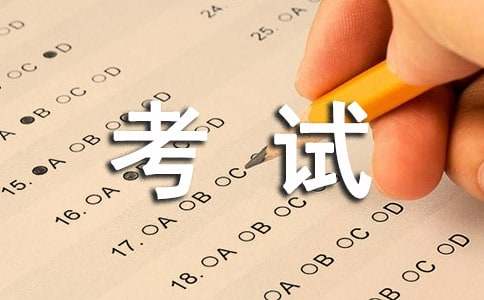- 相關推薦
英語六級考試翻譯原文及解析
引導語:應屆畢業生培訓網為大家整理精選了英語六級考試原文翻譯題,以及相關解析,希望能夠幫助大家。

原文翻譯題一
杭州是浙江省的省會城市的政治、經濟和文化中心。杭州歷史悠久,是中國著名的七大古都之一。杭州也是著名的旅游城市,被譽為人間天堂(paradise),意大利旅行家馬可?波羅(Macro Polo)曾稱贊它為“世界上最美麗華貴之城”。位于市中心的西湖景區以其秀麗的湖光山色和眾多的歷史遺跡聞名中外。杭州特產眾多,其中以絲綢和茶葉最受歡迎。
1.第1句“杭州是......,是......”如依照原文采用并列結構表達為Hangzhou is the capital city of Zhejiang Province,and is...,則稍顯平淡,不如將“是浙江省得省會城市”處理成“杭州”的同位語來得簡潔和有層次感,譯為Hangzhou,the capital city of Zhejiang Province, is...定語“政治、經濟和文化”可用介詞短語 of politics, economy and culture來表達。
2.第2句“杭州歷史悠久,是中國著名的……之一”可用并列結構譯為Hangzhouhas a long history and isone of...,但結構較松散,不如將前半句處理為狀語,用介詞短語With a long history來表達,使譯文更有 邏輯性、結構更緊湊。
3.第4句中的“位于市中心的”可處理為地點狀語,用分詞短語locatedin the center of the city來譯出。“以其秀麗的湖光山色和眾多的歷史遺跡聞名中外”可套用be world-famous for...(以......聞名世界)的結構來表達。“眾多的”可用many或numerous來表達。
4.最后一句的主干為“杭州特產眾多”,可將其作為主句,其中“特產眾多”意即“有眾多特產”,因此翻譯為Hangzhou boasts numerous special local products。而“其中以絲綢和茶葉最受歡迎”為補充說明“特產 眾多”的內容,可用among which引導的非限制性定語從句來表達,譯作among which and tea are themost popular。
參考譯文:
Hangzhou, the capital city of Zhejiang Province, is the provincial center of politics, economy and culture. With a long history, Hangzhou is one of the famous seven ancient capitals in China. It is also a well-known tourist city hailed as "the paradise on earth". Italian traveler Macro Polo once admired Hangzhou as "the most splendid and luxury city in the world". Located in the center of the city, the West Lake scenic spot is world-famous for its beautiful lakes and mountains and many historical relics. Hangzhou boasts numerous special local products, among which silk and tea are the most popular.
原文翻譯題二
麗江古城位于云南省西北部,是納西族聚居的地方。它建于宋代(the Song Dynasty),距今已有800年的歷史,其原貌得以保存完整。自古以來,古城就是遠近聞名的集市。它是中國歷史文化名城中唯一沒有城墻的古城。古城里的建筑深受納西、白、藏(Tibetan)、漢四個民族建筑藝術的影響,充滿了濃厚的中華文化氣息。1997年,麗江被列入世界文化遺產名錄(World Heritage Sites)。
1.第1句“面江古城位于……,是……的地方”可用并列結構譯為the ancient town of Lijiang is located in... and ishome to...,但這樣處理稍顯生硬,不如將前半句處理成地點狀語,用過去分詞短語located in...來表達,主句為theancient town of Lijiang is home to...,譯文主次分明、結構緊湊。
2.第2句中有3個動詞“建于”、“距今有”和“得以保存”,可按原文結構譯出:it was built in... and has ahistory of.., and its original look has been kept intact。但仔細分析可發現,第1、2分句關系較緊密,可以用介詞in將這兩個分句連接起來,譯作It was built 800 years ago in the Song Dynasty。第3個分句用并列結構and its original look...來表達。
3.第4句中的“中國歷史文化名城中”是地點狀語,翻譯“在……中唯一……”這種句式時,一般會把狀語“在 ……中”放于句首,表達為Among..., it is the only...。定語“沒有城墻的”后置,可用定語從句which has nowalls來表達,亦可用介詞短語without walls來表達,但都不如譯文中增譯built—詞好,增譯built更能確切地表達“建城時就沒有城墻”的意義。
4.在翻譯倒數第2句中的納西、白、藏、漢四個民族”時,先譯出其總括詞four nationalities,再用namely或i.e.引出具體內容。
參考譯文:
Located in the northwest of Yunnan Province, theancient town of Lijiang is home to the Naxi ethnicminority. It was built 800 years ago in the SongDynasty and its original look has been kept intact.It has been a very well-known market since theancient times. Among all the famous histories andcultural cities and towns in China, it is the only one built without walls, The architecture of Lijingis deeply influenced by the arts of building of four nationalities, namely Naxi, Tibetan, and Han,and is of rich flavor of Chinese culture. In 1997, it was listed into the World Heritage.
原文翻譯題三
新中國成立后,中國政府一直致力于提高女性的社會地位。經過多年的努力女性群體在社會各個領域產生了不可忽視的力量。近年來,越來越多的女性在政府部門任職,參與的國家政務活動也明顯增多。據最近的一份調查數據顯示,大約每3位企業中高層管理者中就有1位是女性。此外,女性在家庭決策中也扮演著越來越重要的角色。
1.翻譯第2句“……女性群體在社會各個領域產生了不可忽視的力量”時,先譯出主干(females have the power),再插入其他成分。“不可忽視的”處理為后置定語,既可用定語從句that cannot be ignored,也可用不定式短語not to beignored來表達。狀語“在社會各個領域”譯作in every/eachfield of society,置于句末。
2.第3句中的“越來越多的女性……任職,參與的......活動也明顯增多”可用并列結構譯出a growing numberof females take office... and participate in...。但不如把后半句“參與的......”處理成前半句的結果狀語,用現在分詞短語participating in...來表達,使譯文更具有邏輯性。
3.第4句中的“最近的一份調查數據顯示”可表達為according to statistics from a recent survey,也可表達為 statistics form a recent survey showed that...。“每3位”可表達為 one in three,也可表達為one out of three,還可延伸譯作one third of。
4.最后一句中的“越來越重要的”有多種譯法:more and more important; increasingly important;growingly important,狀語“在家庭決策中”表達為 in the family decision-making,置于句末。
參考譯文:
After the founding of New China, the Chinesegovernment has been devoted to improving thesocial status of females. After years of efforts,females have the power not to be ignored in everyfield of society. In recent years, a growing number offemales take office in government departments,participating in more state affairs. According to statistics from a recent survey, about one inthree of mid to high-level enterprise managers are female. In addition, females are alsoplaying an increasingly important role in the family decision-making.
原文翻譯題四
太極拳(Taijiquan)是中華民族的寶貴財富,是東方文化的重要組成部分。作為中國古老的武術(maritialarts)之一。其主要功能是武術攻防、鍛煉身體和修身養性(self-cultivation )。太極拳在演練時,動作柔緩,但能以突然爆發的力量將對手擊退。經過幾個世紀的發展,太極拳已發展為多個分支,每個分支都有自己的特點。如今,太極拳在中國乃至世界受到越來越多人歡迎。
1.第1句可譯為并列結構Taijiquan is precious wealth...and an important part...,系動詞“是”(is)只需譯出一個。
2.第2句中的“其主要功能是”可直譯為its main functionsare to...,但稍顯生硬,宜轉述為“它通常用于”(it is usuallyused for...)。“攻防”在中文里是一個詞,但實際包含了兩層意思,故分譯為attacking and defending;同理,第3句的“柔緩”譯為gentle and slow。
3.第3句中的“太極拳在演練時”實為被動句,“太極拳”為受動者,故譯作When Taijiquan is beingpractice...。“但能以突然爆發的力量......”處理為which引導的非限制性定語從句which,however, candefeat。“突然爆發的力量”可譯為sudden strength或sudden force,因為sudden已包含有“突然爆發”的意思,故“爆發”一詞不需再譯。
4.最后一句中的“在中國乃至世界受到越來越多人歡迎”,除譯文外,還可以有多種譯法,如is welcomed bymore and more people both in China and overseas;is accepted by more and more people inChina and the world as well。
參考譯文:
Tajiquan is precious wealth of Chinese nation andan important part of the eastern culture. As one ofthe ancient martial arts in China, it is usually usedfor attacking and defending, body building and self-cultivation. When Tajiquan is being practiced, themovements are gentle and slow, which, however,can defeat the opponent with sudden strength. Through centuries of development, Taijiquanhas developed into several branches, and everyone has its features. Now Tajiquan has becomeincreasingly popular both in China and abroad.
翻譯原文題五
算盤(abacus)是中國古代的一項偉大發明。在古代,人們用小木棍進行計算隨著社會的發展,需要計算的數目越來越大,用小木棍已無法憲成計算。于是,人們發明了更為高級的計算工具一一算盤。由于算盤操作方便、簡單易學,因此在中國被廣泛使用。在算盤的基礎上,有人發展了珠心算(mental abacus),即把算盤的形象描繪在腦海中來計算數字。
1.第1句由3個短句構成,第1個短句譯成介詞短語Withthesocial development或連詞as引出的從句As the societydeveloped;第2個短句可處理為主句,當中的定語“需要計算的”可譯為分詞短語 needed to calculate,作后置定語;第3個短句則處理成用which引導的非限制性定語從句,套用make it impossible for sb./sth. to do sth.的結構,譯成which made it impossible for the rods to fulfill the task,為了避免重復,把“完成計算”轉譯成了“完成任務”。
2.第4句中破折號后的內容“算盤”是前面“更為高級的計算工具”的同位語,譯文處也可用破折號引出。
3.第5句中的“由于算盤操作方便、簡單易學”可套用英語常用句式It is+ a. + to do sth.,譯為Since it wasconvenient to use and easy to learn。雖然中文出現了“由于......因此......”,但譯為英語時不能同時出現“Since... so...”。
4.最后一句中的“有人發展了珠心算”如果逐字對譯為someonehas developed...則顯晦澀,且主語“有人”無需強調,故轉換主語為“珠心算”,用there came句型,表存現狀態。“即把算盤的形象……”是對“珠心算”的補充說明,可用介詞短語 with the image of an abacus in mind to calculate the figures 來表達。
參考譯文:
The abacus is a great invention in ancient China. Inthe old times, people used small rods to count, Withthe social development, numbers needed tocalculate were increasingly greater, which made itimpossible for the rods to fulfill the task. Thus,people invented a more advanced calculating devicethe abacus. Since it was convenient to use and easy to learn,the abacus was widely used inChina. On the basis of the abacus, there came the mental abacus with the image of anabacus in mind to calculate the figures.
翻譯原文題六
據說《茉莉花》(Jasmine Flower)是流傳到海外的第一首中國民歌。許多國外學者在研究中國音樂史時都提到了《茉莉花》,不少外國人學唱中文歌時首選這首歌。2004年雅典奧運會(Athens Olympics)閉幕式上, 一位中國小姑娘唱起《茉莉花》,給所有觀眾留下了深刻的印象。2008年北京奧運會,《茉莉花》被選為頒獎典禮 (awarding ceremony)的音樂。這首歌帶給我們美好藝術享受的同時也帶給我們驕傲。
1.第1句“據說《茉莉花》是……第一首中國民歌”可譯為It issaid that Jasmine flower is the first...,但不如譯文說的Jasmine Flower is said to be the first...來得簡單。定語“流傳到海外的”較長,故將其處理成后置定語,用表被動的過去分詞短語introduced to foreign countries來表達。
2.第2句中的“在研究中國音樂史時”為時間狀語,處理成從句,英譯時需增譯出從句主語they,表達為whenthey study the history of Chinese music,置于主句之后。“不少外國人學唱中文歌時首選這首歌”可逐字對譯為 many foreigners who would like to learn to sing Chinese songs would first choose thissong,但譯文繁冗拗口。根據“漢語多用動詞,英語多用名詞”的表達差異,考慮將“首選這首歌”譯為the firstchoice,用結構 it is the first choice for sb.譯出。
3.第3句中的“給所有現眾留下了深刻的印象”可用并列結構and greatly impressed...,但不如將其處理成非限制性定語從句好,譯作which greatly impressed all the audiences更能體現原文的邏輯關系。
4.最后一句“這首歌帶給我們……的同時也…”可套用句型sth brings sb. both... and...,故譯為This songbrings us both great artistic enjoyment and pride。
參考譯文:
Jasmine Flower is said to be the first Chinese folksong introduced to foreign countries. A lot ofscholars abroad have mentioned Jasmine Flowerwhen they study the history of Chinese music. It isthe first choice for many foreigners who would like tolearn to sing Chinese songs. In closing ceremony ofthe 2004 Athens Olympics, a Chinese girl sang this song, which greatly impressed all theaudiences. In 2008 Beijing Olympics, it was chosen as the music played in awarding ceremony.This song brings us both great artistic enjoyment and pride.
【英語六級考試翻譯原文及解析】相關文章:
大學英語六級考試翻譯技巧解析09-01
英語六級翻譯練習和解析06-06
2016英語六級翻譯原文08-09
2016英語六級翻譯原文及答案10-20
英語六級考試翻譯技巧01-22
英語六級翻譯原文及答案(通用61篇)11-27
英語六級考試翻譯核心詞11-27
英語六級考試翻譯練習材料07-21
英語六級考試翻譯備考技巧08-08